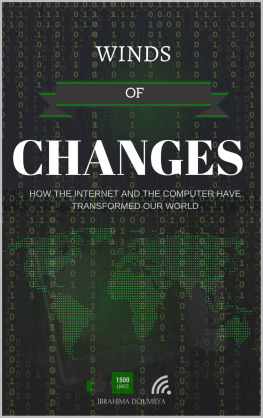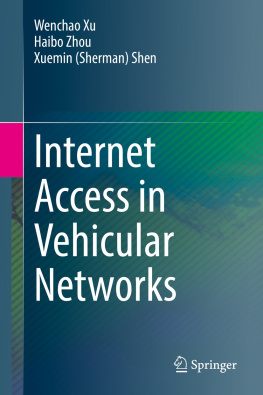WINDS OF CHANGES
How the internet and the computer have transformed our world
IBRAHIMA DOUMBYA
Copyright 2017 by Ibrahima Doumbya. All rights reserved
This book remains the property of the author, and may not be redistributed to others without prior authorization.
Cover design by Ibrahima Doumbya
Content
Acknowledgements
Introduction
Chapter 1: Looking Back
Chapter 2: These Past Fifteen Years
Chapter 3: Forever Greater Access
Chapter 4: Creative Participation
Chapter 5: The Maximization of Happiness
Chapter 6: New Issues
Chapter 7: Disappearing Frontiers
Conclusion
Glossary
Bibliography
Acknowledgments
I am greatly indebted to the Wisconsin Public Library System for the research materials that made this book possible.
Many thanks go to Marquette University Track and Field for the opportunity to travel with the team as an assistant coach.
Special thanks to all the schools that I have had the privilege of attending.
Many thanks go to my teachers for their invaluable help.
I am very grateful for the continuous support of my family and friends.
Finally, I would like to thank my parents for instilling in me the values of patience and persistence.
Introduction
Several trips in different cities in the United States for a few months forever changed my perspective on life and on technology. From airports to main streets, marketplaces, and the stadiums that I had the privilege of visiting, there were visible signs of our changing world. Indeed, dramatic transformations in the field of technology have transformed the landscape of communication in a relatively short amount of time, and the scale with which I was going to witness them blew my mind away. Almost everyone I came across was fully engaged with a digital device. Smartphones, tablets, e-readers, and laptops were everywhere. To be frank, I saw them more than I saw people. In fact, the intensities of our engagements with these devices in our daily lives are enough to remind anyone of the power and pervasiveness of digital technologies in the modern era.
That experience motivated me to devote my time studying the technological changes in communication that are sweeping across our world and the many ways we are changing as a result. We have now placed the computer and the internet at the center of our lives, using them to learn, to teach, to shop, to work, and to entertain ourselves. Billions of web pages exist today in cyberspace. Each one of them is vying for our attentions every single day.
But first, I would like to stress that I was more than an observer of these trends because I was also an active consumer of digital technologies. With a tablet computer and a print book as companions during my trips, I was enjoying both the old and the new. I was literally half-way between the world Gutenberg helped create and the Electronic Age that Marshall McLuhan wrote about a few decades ago.
Just a few years ago, books, newspapers, and magazines would have been the main choices on how to spend the time, especially on long trips. Now, digital devices have taken over, marking the dawn of a new era in which they intend to dominate all other modes of communication and entertainment.
Luxuries that a few could really afford, connected devices are ubiquitous almost everywhere in the world today. Therefore, all of us, irrespective of our levels of expertise, have an obligation to understand their implications so that we can minimize their drawbacks and maximize their potentials to positively impact our lives.
For my part, I wanted to dig a little deeper into these trends. My first idea was to build a website, to share news and articles about technology in our contemporary world. But the search for an appropriate method and platform led me to the blogosphere. There, things started to shape themselves. A blog would be perfect to begin a journey of discovery and learning. I could reflect on the topics I was interested in and work on a product that I would later share. Thus was born Winds of Changes .
My plan was simple. First, I intended to use the Web as a primary source. Second, I needed to spend some time at the library. Third, I had to take classes on the subject if the opportunity presented itself. I did all that rather smoothly because of the rich knowledge and information extant on the Web, at the library, and in the many online courses now available to almost anyone.
Winds of Changes was the perfect setting to uncover the shape of the present narrative on technological change, especially in the areas of the internet and computer technology. I chose that name, not in reference to a world-famous pop song, but to produce concise and hopefully compelling essays on the varied and complex ways in which computers and the internet are changing our world by blowing, like the wind, old paradigms away to bring new ones to the fore.
The blog lasted for two and a half years. This present work is its everlasting legacy.
As you know, technology can be disruptive, destructive, and awe- inspiring. It can have several purposes. It is always created out of our desire to enhance and extend our capacity to do, see, and hear. We also create technology because we want to control our environment and increase our odds for survival. For instance, as an extension of the eye the microscope helps us see the world of germs and other tiny organisms, thus giving us the ability to learn more about them and fend off the diseases they may bring.

The microscope
The telescope uncovers the sky above us, helping us see distant stars in our galaxy. We can dream of other planets and even hope that other living species exist in some of them.

The telescope
The microscope and the telescope are powerful technologies that changed our perception of the world and added value to our lives. They both enhance our ability to understand the world we live in. We are not alone if we look into a microscope, neither are we the center of the universe when we observe it through the lenses of a telescope. The Hubble Space Telescope , the most powerful one in the world, brings more focused images of our galaxy every day, reminding us of how crowded and colorful the universe is.
But technology sometimes enhances our quality of life only after we have abandoned something. This is when we talk about disruptive technology. It aims to destroy the old in order to bring in the new. To enjoy the new we have to leave the old. The computer was a disruptive technology when it was invented. Indeed, to write the manuscript of this book in a pre-computer era I would either rely on a pencil and paper or a typewriter. While both were good, they pale in comparison with the computer today.

The typewriter
Therefore, by providing a better alternative, the computer has disrupted our relationship with the typewriter and now increasingly with the pencil and the paper.
My great grandmothers encounter with the railroad in early 20th century Africa illustrates this disruptive side of technology on a different scale and in a different context. Her story took place in pre-independent Senegal when the country was part of French West Africa. The administrators of the colony wanted to build a railroad to connect Saint Louis, then capital of French West Africa, to Dakar, an important port city and a strategic location for France in the continent. While the story of the railroad expansion is truly connected to the general history of the country, for my great grandmother, it was personal on many levels and in ways that few people experienced. Below is how my mother told me her story.
Next page








